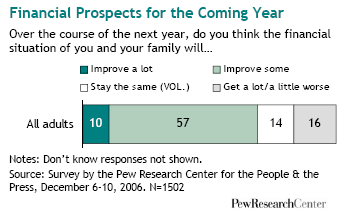 Most Americans are moderately upbeat about their family’s financial prospects in the coming year, with 57% expecting some improvement in their financial situation and another 10% expecting a lot of improvement, according to a new Pew Research Center survey.
Most Americans are moderately upbeat about their family’s financial prospects in the coming year, with 57% expecting some improvement in their financial situation and another 10% expecting a lot of improvement, according to a new Pew Research Center survey.
These findings are in line with Pew surveys taken throughout this decade that have shown that most members of the public expect to see at least some improvements in their financial situation in the coming year. At the same time, however, the survey also finds wide variances in the way Americans assess their financial situation right now.
 About four-in-ten (38%) adults in this country say they are living comfortably; another three-in-ten (28%) say they have enough money to meet expenses with a little left over for extras; and about one-in-three (32%) say either that they are just meeting basic living expenses or that they don’t have even enough for the basics.
About four-in-ten (38%) adults in this country say they are living comfortably; another three-in-ten (28%) say they have enough money to meet expenses with a little left over for extras; and about one-in-three (32%) say either that they are just meeting basic living expenses or that they don’t have even enough for the basics.
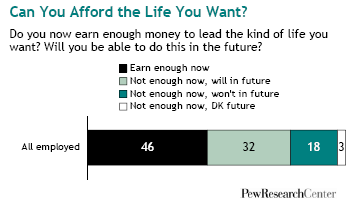 A similarly stark division emerges when employed Americans are asked whether they earn enough money to lead the life they want. Just under half (46%) say they do, while 53% say they don’t. Among the group that says they don’t earn enough now, most expect to earn enough in the future to lead the life they want. Just 18% of all employed respondents in the survey say both that they don’t make enough now and that they don’t expect ever to make enough to have the life they want.
A similarly stark division emerges when employed Americans are asked whether they earn enough money to lead the life they want. Just under half (46%) say they do, while 53% say they don’t. Among the group that says they don’t earn enough now, most expect to earn enough in the future to lead the life they want. Just 18% of all employed respondents in the survey say both that they don’t make enough now and that they don’t expect ever to make enough to have the life they want.
These findings are from a new Pew Research Center survey on personal finances conducted by telephone from October 18 through November 9, 2006 among a randomly – selected nationally – representative sample of 2,000 adults.1
Other key findings include:
- Youth, or at least relative youth, is strongly correlated with expectations of brighter financial prospects in the coming year. Adults under age 50 are more optimistic than their elders that financial improvements are coming their way. Those ages 65 and older, most of whom are retired, are the least optimistic; this group is more likely to volunteer that their financial situation will stay-the-course or get worse.
- When survey respondents report “the biggest problem facing you and your family” in an open-ended question, the single most common problem mentioned (by 25% of all respondents) is not having enough money to pay the bills and meet expenses. A total of 36% mention a broader array of financial problems, whether it is bill-paying, cost of living, unemployment, low-paying jobs, gas prices, taxes or the like.
- Nearly four-in-ten (38%) adults and 32% of American workers say they have no retirement plan other than Social Security. The groups least likely to have a retirement plan include: adults under age 30; Hispanics and non-Hispanic blacks, and those with annual family incomes under $30,000.
- A majority of Americans report that their family’s income is either keeping up with the cost of living (44%) or doing better than that (12%). But fully four-in-ten say their family’s income is falling behind the cost of living. These figures are a bit less downbeat than they were in January 2006 when 47% said they were falling behind.
- Married adults (43%) are more likely to report living comfortably than the unmarried (31%). Those not married—especially unmarried women—are more likely to report having trouble meeting their basic expenses.
Optimism for the Year Ahead
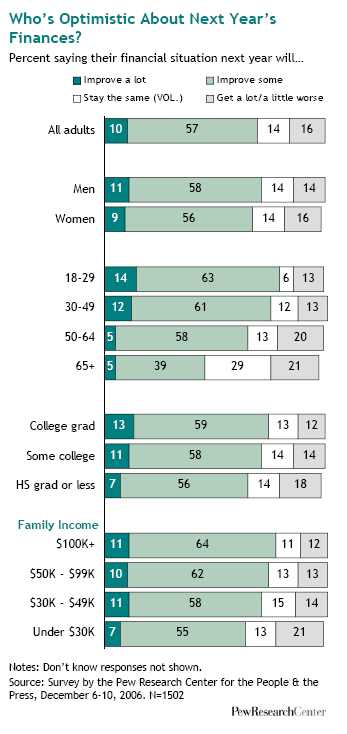 Two-thirds of Americans expect their family’s financial situation to improve over the next year by a lot (10%) or some (57%), while 16% think their financial situation will get worse and a similar portion (14%) volunteer that they expect to stay the same financially. These figures come from a separate Pew survey conducted December 6-10, 2006 with 1,502 randomly-selected and nationally representative sample of adults. (The margin of sampling error for this survey is +/- 3 percentage points.)2
Two-thirds of Americans expect their family’s financial situation to improve over the next year by a lot (10%) or some (57%), while 16% think their financial situation will get worse and a similar portion (14%) volunteer that they expect to stay the same financially. These figures come from a separate Pew survey conducted December 6-10, 2006 with 1,502 randomly-selected and nationally representative sample of adults. (The margin of sampling error for this survey is +/- 3 percentage points.)2
Financial expectations vary by age. Adults on the younger side (ages 18 to 49) are more likely than those ages 50 and older to expect their finances to improve. Those ages 65 and older, many of whom are retired from the work force, are more likely than other age groups to either volunteer that they expect their financial situation to remain about the same or to expect it to get worse in the coming year.
Older men (ages 50 and older) are a bit more optimistic than are older women but there is no gender difference among younger adults. And, those with lower family incomes (under $30,000 a year) are less optimistic than those with higher incomes.
Optimism for the Life Ahead
 When looking over a broader horizon American workers are roughly split between those reporting they now earn enough money to lead the kind of life they want (46%) and those who don’t (53%). Among workers who report not earning enough money now, the optimists outnumber the pessimists by 2:1 that at some point in the future they will earn enough to support their desired lifestyle.
When looking over a broader horizon American workers are roughly split between those reporting they now earn enough money to lead the kind of life they want (46%) and those who don’t (53%). Among workers who report not earning enough money now, the optimists outnumber the pessimists by 2:1 that at some point in the future they will earn enough to support their desired lifestyle.
A similar divide exists among those not in the labor force; 48% of this group says they now have enough income to lead the kind of life they want while 49% does not. There are fewer optimists about the future among this group. Those not employed are almost evenly divided between those who expect to have enough in the future and those who don’t expect to have enough income to lead the kind of life they want.
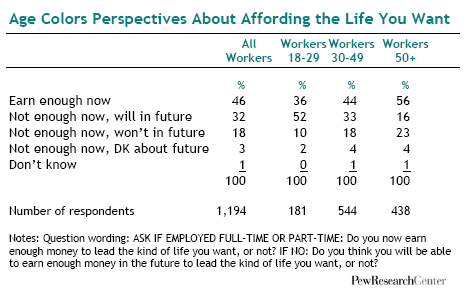
Age and life stage are strongly related to responses on this question. Older workers (56%) are more likely than younger ones (36%) to say they now earn enough to lead the kind of life they want. But younger workers are considerably more optimistic than their elders that they’ll make enough at some point in the future to do this.
Finances Top List of Family Concerns
 The optimism most Americans show for their pocketbooks in the coming year does not mean that financial concerns are unimportant. In fact, when survey respondents are asked to put in their own words the biggest problem they and their families face, financial concerns dominate the list. About 36% of responses explicitly focus on personal finances and economic issues. An equal portion (36%) of responses focuses on other kinds of problems, but some of these include a financial component, such as the cost of health care and education. Another three-in-ten indicate they either don’t know or see no particular problems facing their families.
The optimism most Americans show for their pocketbooks in the coming year does not mean that financial concerns are unimportant. In fact, when survey respondents are asked to put in their own words the biggest problem they and their families face, financial concerns dominate the list. About 36% of responses explicitly focus on personal finances and economic issues. An equal portion (36%) of responses focuses on other kinds of problems, but some of these include a financial component, such as the cost of health care and education. Another three-in-ten indicate they either don’t know or see no particular problems facing their families.
The dominance of concerns about making ends meet is consistent with previous surveys asking this question since the early 1990’s. About a quarter (26%) of responses to a Pew survey conducted in May 2005 mentioned the high cost of living or trouble making ends meet compared with 28% in this survey. In past surveys, respondents were somewhat more likely to also cite a broader array of concerns related to the national economy such as unemployment and recession.
As expected, those with higher family incomes are less likely to mention financial concerns while those with incomes under $50,000 are more likely to do so. Similarly, older adults are more likely to cite health and aging-related concerns than are those in their younger years (ages 18 to 49).
Personal Financial Situation
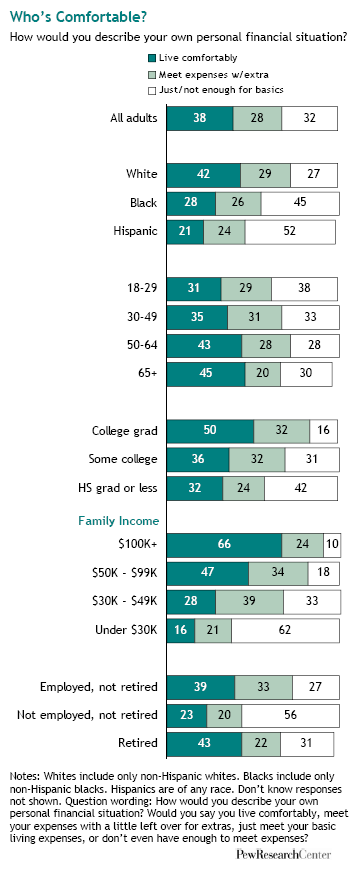 When it comes to assessing their current financial situation, Americans are roughly divided among those living comfortably (38%), those who are meeting their living expenses with a little left over for extras (28%) and those for whom their basic living expenses meet or outstrip their resources (32%).
When it comes to assessing their current financial situation, Americans are roughly divided among those living comfortably (38%), those who are meeting their living expenses with a little left over for extras (28%) and those for whom their basic living expenses meet or outstrip their resources (32%).
Not surprisingly, this assessment of personal finances is correlated with income and education. Those with higher family incomes are more likely to see their financial situation as one that allows them to “live comfortably.” Further, more college graduates than those with less education say they “live comfortably.”
Adults ages 50 and older are more likely than their younger counterparts to say they live comfortably. Employment status is also important, of course. Retirees and workers are more likely to report living comfortably than are non-retirees who are not employed.
Non-Hispanic whites, more so than either Hispanics or non-Hispanic blacks, report living comfortably.
Married couples (43%) are more inclined than the unmarried (31%) to describe themselves as living comfortably.
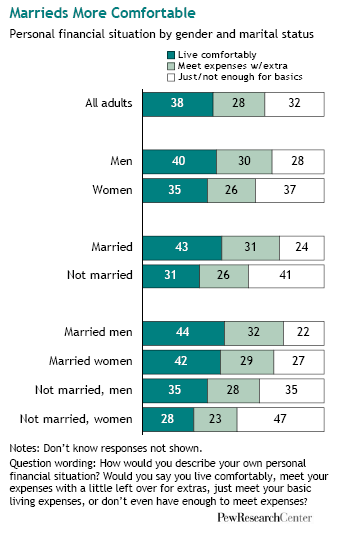 When it comes to gender, there is a slight tendency for more men than women to report living comfortably. However, the gender gap is stronger at the other end of the financial spectrum; women (37%) are more likely than men (28%) to say they are not meeting or are just meeting their basic living expenses.
When it comes to gender, there is a slight tendency for more men than women to report living comfortably. However, the gender gap is stronger at the other end of the financial spectrum; women (37%) are more likely than men (28%) to say they are not meeting or are just meeting their basic living expenses.
This pattern is especially strong for unmarried women—both for those who have never married and for those who are widowed, divorced, or separated. Nearly half (47%) of unmarried women, compared with just 27% of married women, say they are not or are just meeting their basic living expense; a marriage gap among women of 20 points. The pattern is the same among men but not as strong; 35% of unmarried men compared with 22% of married men describe themselves as either not having enough or having just enough to meet their basic living expenses.
Do You Need a COLA?
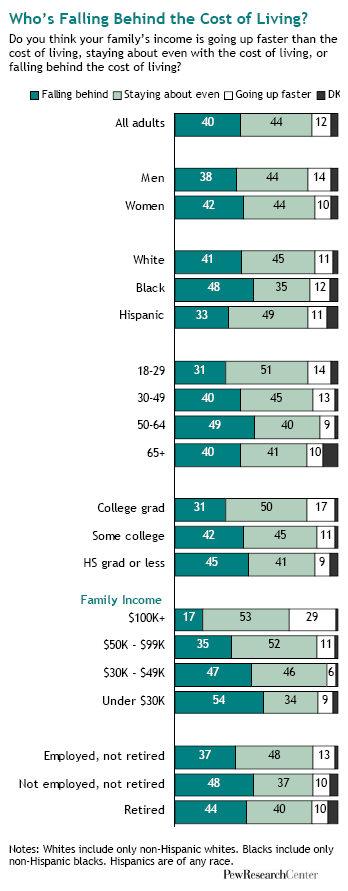 A majority of Americans report that their family’s income is either keeping up with the cost of living (44%) or doing better than that (12%). But fully four-in-ten say their family’s income is falling behind the cost of living. These figures are a bit less downbeat than they were in January 2006 when 47% said they were falling behind.
A majority of Americans report that their family’s income is either keeping up with the cost of living (44%) or doing better than that (12%). But fully four-in-ten say their family’s income is falling behind the cost of living. These figures are a bit less downbeat than they were in January 2006 when 47% said they were falling behind.
As expected, those at the lower ends of the income spectrum are especially likely to feel they are falling behind. More than half (54%) of those with incomes under $30,000 a year say their income is falling behind the cost of living and 47% of those earning between $30,000 and $50,000 say the same.
Adults ages 50 to 64 are more likely than their older or younger counterparts to feel they are falling behind.
There is some variance in this assessment by marital status. Marrieds (38%) and singles who have never married (33%) are less likely than those who are widowed, divorced or separated (49%) to say their income is falling behind inflation. This figure climbs to 61% among those ages 50 to 64 who are widowed, divorced or separated compared with 38% among those ages 65 and older and 49% among those 18 to 49 who are widowed, divorced or separated.
These responses come at a time when the non seasonally-adjusted Consumer Price Index from the Bureau of Labor Statistics rose about 2% over the past year (November 2005 to November 2006). Back in January, when Americans were a bit more downbeat, prices rose about 4% over the previous year (January 2005 to January 2006).
Financial Plans for Retirement
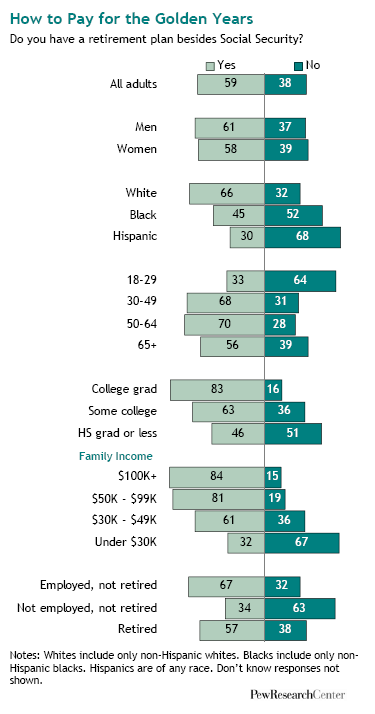 A majority (59%) of Americans have some kind of retirement plan apart from Social Security, but nearly four-in-ten (38%) adults and 32% of all workers say they have no retirement plan other than Social Security. Among those who are not employed and not currently retired, nearly two-thirds (63%) say they have no retirement plan other than Social Security.
A majority (59%) of Americans have some kind of retirement plan apart from Social Security, but nearly four-in-ten (38%) adults and 32% of all workers say they have no retirement plan other than Social Security. Among those who are not employed and not currently retired, nearly two-thirds (63%) say they have no retirement plan other than Social Security.
Hispanics and non-Hispanic blacks are more likely than non-Hispanic whites to say they have no retirement plan other than Social Security. These findings are consistent with other reports showing wide disparities along racial and ethnic lines in financial assets.3
Young adults (ages 18 to 29) are less likely than their elders to have any kind of retirement plan besides Social Security.
As expected, retirement finances are related to income. Fully two-thirds (67%) of those with family incomes under $30,000 per year have no retirement plan other than Social Security. Similarly, among those who describe their personal financial situation as either just enough or not enough to meet their basic living expenses, some 61% report that they have no retirement plan other than Social Security. This compares with 24% among those who report living comfortably and 32% among those who are meeting their expenses with a little extra.
Satisfaction with Life
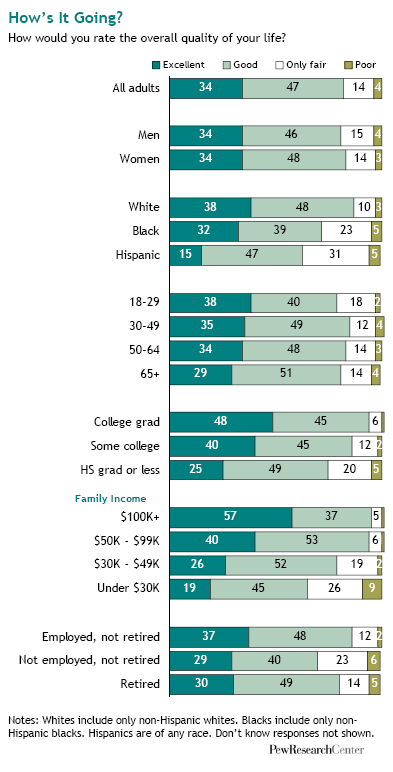 More than a third (34%) of Americans rate the overall quality of their life as excellent, while 47% consider it good and just 18% rate the quality of their life as only fair or poor.
More than a third (34%) of Americans rate the overall quality of their life as excellent, while 47% consider it good and just 18% rate the quality of their life as only fair or poor.
There is no difference on this rating between men and women, although among those ages 50 and older, women are less likely to rate their quality of life as excellent (29%) compared with men in the same age group (36%).
Those who are married are more likely than the unmarried to give the quality of their life an excellent rating. And workers are more likely than retirees or non-retirees who are not employed to see their overall life quality as excellent.
Income figures into these calculations as well. A majority (57%) of those with family incomes of $100,000 and above rate their lives as excellent. By comparison, just 19% of those with family incomes under $30,000 rate the quality of their lives as excellent.
About the Survey
Results for this survey are based on telephone interviews conducted with a nationally representative sample of adults, ages 18 years and older, living in continental U.S. telephone households.
- Interviews conducted Oct. 18 – Nov. 9, 2006
- 2,000 interviews
- Margin of sampling error is plus or minus 2.5 percentage points for results based on the total sample at the 95% confidence level. The margin of sampling error is higher for results based on subgroups of respondents.
Survey interviews conducted under the direction of Princeton Survey Research Associates International. Interviews were conducted in English and Spanish.
Bear in mind that question wording and practical difficulties in conducting surveys can introduce error or bias in the findings of opinion polls.
Read the full report for more details.


